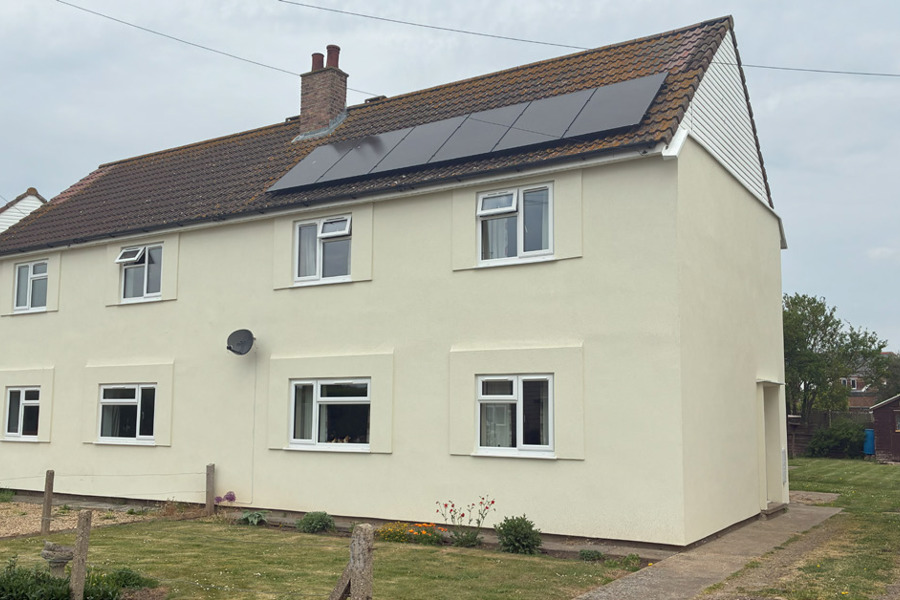The Big Switch: Phasing out gas in European social housing - what the UK can learn
By Dr. Jan Rosenow
Phasing out gas from social housing is crucial in achieving climate targets and protecting residents from unpredictable energy prices. In the UK, more than 80% of social housing relies on gas boilers, a reality that makes our climate targets unachievable and leaves residents exposed to volatile energy prices. While we are starting to grapple with this challenge, our European neighbours are already miles ahead in executing bold, often more comprehensive strategies. Their experiences provide insights into how to phase out gas in social housing effectively and at scale.
Germany: quality over speed
Germany’s fundamental approach up to now has been a "fabric first" strategy, which tackles the causes of high energy use. Rather than substitute a gas boiler with a low-carbon heating system, German policy opts for an ambitious deep retrofit of the building envelope. This has included high levels of external insulation, excellent performance triple-glazed windows and very strict airtightness. The aim is to achieve energy savings of 75% or more; this standard can often be met by the EnerPHit standard.
This is a crucial first step in transitioning away from gas. But it has one downside: It is expensive. The German government, channelled through its state-owned KfW Development Bank, finances the bank's ability to work. They provide long-term, low-interest loans and significant grants, so our social housing providers can focus on these complex developments. This is in sharp contrast with the UK's stop-start funding programmes, which can't grow a market, where supply chains can't expand, and housing associations can't plan more than 12 or 24 months. What is remarkable is that the KfW programmes have remained incredibly stable despite significant political turmoil and changes in government. KfW also offers support for new heating systems such as heat pumps. Importantly, KfW's support for heat pumps is not a standalone offer, but is integrated into its broader retrofitting programs, such as the Federal Funding for Efficient Buildings. For instance, housing associations can secure loans of up to €150,000 per residential unit for comprehensive retrofits to an "Efficiency House" standard. These projects often involve replacing gas boilers with heat pumps.
In Berlin, for instance, the social housing company degewo has undertaken projects where they combine deep insulation with the installation of heat pumps, often integrated with solar panels on the roof. This holistic approach ensures the heat pump operates at high efficiency, genuinely lowering bills and carbon emissions. A project by the housing cooperative Wohnungsbaugenossenschaft Gartenstadt Süd eG involved installing ground-source heat pumps and completely upgrading the building's insulation and windows, effectively creating a future-proof, low-carbon heating system. The result: The tenants paid less than a quarter of the cost for heating after the retrofit.
This is a very capital-intensive approach, but for the residents in the retrofitted buildings, it means improved comfort and lower bills without relying on gas. It will be interesting to see how Germany maintains this path as the pace of phasing out gas for heating accelerates.
Netherlands: a focus on industrialisation
The Netherlands has faced a similar challenge with its large stock of post-war social housing and a heavy reliance on gas heating systems. Their solution, however, has been revolutionary. Instead of treating each retrofit as a bespoke construction project, they industrialised the entire process through the Energiesprong programme. This model is built on economies of scale and innovation. They've created a market for prefabricated retrofit packages, which can include new insulated facades with windows, and roof panels with integrated solar photovoltaics and heat pumps. These are manufactured off-site and then installed with minimal disruption to tenants, often in a matter of days.
The real genius of Energiesprong lies in its financing model. Housing associations enter into long-term performance contracts with retrofit companies, who guarantee that the retrofitted homes will achieve net-zero energy use. The cost of the retrofit is then paid back over decades, with the repayments often funded by the tenant's future energy savings. It de-risks the investment for the housing provider and provides the contractor with the long-term certainty they need to invest in new manufacturing and skills. It also guarantees a direct, tangible benefit for the tenant: a warm home and a predictable, low energy bill.
Poland: leveraging EU funds for decarbonisation
Poland’s approach to retrofitting its vast stock of socialist-era housing offers a different, but equally important, lesson. Faced with a legacy of inefficient apartment blocks and reliance on coal-fired district heating, the country has leveraged significant financial support from the European Union. Poland has been one of the largest beneficiaries of the EU’s Cohesion Fund and Regional Development Fund, with a substantial portion of this money earmarked for improving energy efficiency.
This funding has enabled many social housing associations to undertake deep retrofits, which often include external wall insulation, window replacement, and, crucially, a shift from fossil-fuel-based heating. Many projects connect to district heating (which is currently still carbon-intensive) or use individual or communal heat pumps.
The Polish model demonstrates how external, long-term financial instruments can serve as a powerful catalyst for a nationwide retrofit programme, particularly in economies with limited domestic capital for such large-scale transitions.
France: the power of a national strategy
France has shown that having a clear, national roadmap is essential for making progress. They have a long-term strategy for building renovation with a hard target to have a low-energy building stock by 2050. It is backed by significant and consistent government funding through schemes.
For social housing, the government utilises public financial institutions to provide a combination of grants and low-interest loans, thereby creating a more stable funding environment. But France's strategy isn't just about money. They’ve also made “one-stop shops” to simplify the process for social housing providers, offering a single point of contact for technical, financial, and administrative advice. This streamlined approach tackles the complexity that often slows down retrofit projects in the UK. Furthermore, the phased prohibition on renting out the least energy-efficient homes provides a powerful regulatory driver for action, giving housing associations a clear incentive to invest now rather than later.
What the UK can learn
The UK's approach to social housing retrofits often feels like a series of fragmented, short-term experiments rather than a coherent, national strategy. We have a lot to learn from our European counterparts. We need to move beyond simple start-stop grant schemes and embrace long-term, stable funding models that encourage more comprehensive retrofits. Importantly, replacing the heating systems at the same time as improving the fabric efficiency of buildings is a must if we want to move away from gas. Finally, we must establish a clear, long-term policy framework. France is a great example that provides social housing providers with the confidence to invest in the future.

Jan Rosenow is Professor of Energy and Climate Policy at the University of Oxford and leads the Energy Programme at the Environmental Change Institute. He is a Jackson Senior Research Fellow at Oriel College, a Senior Associate at the Cambridge Institute for Sustainability Leadership, and a Senior Advisor at the Regulatory Assistance Project (RAP).
A leading expert on energy policy, efficiency, and electrification, he advises governments and organisations including the World Economic Forum, United Nations, and International Energy Agency. His work has shaped major energy and climate policies and appeared in The New York Times, Forbes, The Economist, and the BBC. In 2024, he was named the most-read thought leader on the energy transition.


